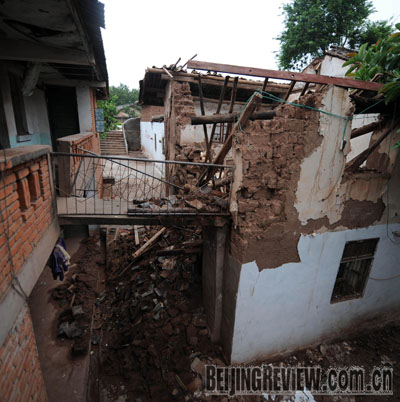| 
SCHOOL DELAYED: The dormitory building of a primary school in Yuanmou County,
Yunnan Province, lies in ruins after the earthquake.
On August 30, a 6.1-magnitude earthquake hit southwest China, the border of Sichuan Province and Yunnan Province. Panzhihua City, Huili County in Sichuan and Yuanmou County and Yongren County in Yunnan were worst hit.
As of 8 a.m. on September 3, the number of people known killed by the earthquake had reached 38, and injured, 982. More than 90 towns and 550,000 residents were affected.
After the earthquake, the Central Government and local governments took urgent measures to rescue people. On September 1, the Ministry of Civil Affairs and the Ministry of Finance allocated 16 million yuan ($2.3 million) and 11 million yuan ($1.6 million), respectively, to the two provinces. More than 50,000 people, including policemen and soldiers, were sent to the quake-hit area to help with the rescue work.
"The quake-hit places are mostly in mountainous areas with complicated geological structures and bad transportation conditions. This creates difficulties for the rescue work," said Huang Jianfa, Director of the Earthquake Emergency Relief Division of the China Seismological Bureau, at a press conference on September 3.
Just one day after the earthquake, another 5.6-magnitude earthquake hit the same area, and there have been several hundred aftershocks since, adding to the destruction.
The epicenter of the earthquake is just on a south-north seismic belt, which has been hit by many earthquakes in the past. A 6.7-magnitude quake, which occurred in 1955, was the strongest since the founding of the People's Republic of China in 1949. In 2003, two earthquakes of 6.2- and 6.1-magnitude hit the area, killing 19 people. This time, despite being the same magnitude as the 2003 quake, more devastation was caused because of a growing population and poorly built housing.
The area hit by this earthquake is relatively underdeveloped, and it is impossible to rely solely on the local government and people for the rescue work. How to resettle people who have lost their homes and how to reconstruct the houses damaged by the earthquake are two crucial problems for the government.
"We must make sure that everybody can live in shelters or temporary houses for the cold winter," said Pang Chenmin, Deputy Director of the Ministry of Civil Affairs' Disaster Relief Department.
"We will arrange one or two temporary houses for every household before winter. In October, we will encourage people in other areas to donate quilts and clothes as well."
| 